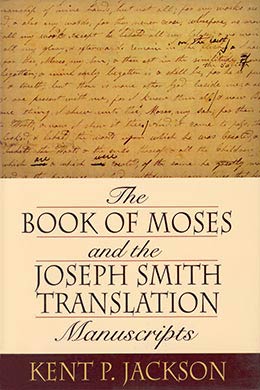Historical Text
Kent P. Jackson, The Book of Moses and the Joseph Smith Translation Manuscripts (Provo, UT: Religious Studies Center, Brigham Young University, 2005), 53–56.
The following is a transcription of the Book of Moses, Genesis 1:1–6:13, from Old Testament Manuscript 2 (OT2), Joseph Smith’s final draft of his New Translation of Genesis. It is found on pages 1–27 of that manuscript. The Prophet first dictated this part of Genesis between June 1830 and February 1831. Oliver Cowdery, John Whitmer, Emma Smith, and Sidney Rigdon assisted him as scribes. In the original dictated manuscript, Old Testament Manuscript 1 (OT1), the Book of Moses material is found on pages 1–21. The present manuscript (OT2) is a copy of the original, made by John Whitmer in March 1831. With very few exceptions, OT2 was the document on which Joseph Smith continued to refine the translation. He added to it numerous insertions and corrections, dictating them primarily to his scribe Sidney Rigdon. The present transcription preserves carefully the words of the manuscript, including words inserted after the original writing. Unless otherwise noted, the handwriting is that of John Whitmer.
The footnotes in the Historical Text show the history of the words from the original manuscripts to the current (1981) edition of the Pearl of Great Price. They include all the manuscripts and editions of the Book of Moses that comprise the genealogy of today’s text, and they also include the early printings in Latter-day Saint periodicals and elsewhere from which later editions sometimes drew textual changes.
Editorial Procedures [1]
• Punctuation marks, which were added by unidentified hands after the text was written, are represented without change. Where revisions were made in punctuation, only the final punctuation is shown.
• Canceled text, whether written over or removed through erasure or strikeout, is shown lined out (for example, word).
• Scribal insertions are shown in angle brackets (for example, <word>).
• Letters from canceled words that were reused as part of inserted words are shown as deleted and inserted (for example, was <were> instead of was<ere>).
• Errors corrected by scribes in their own writing are not shown. Insertions made by scribes to correct their own writing are not identified as insertions.
• Original line endings have been retained. When a line of text is too long for the available space, subsequent text is indented.
• Original capitalization has been retained. Where revisions were made in capitalization, only the final capitalization is shown.
• Spelling has been standardized to modern usage; spelling of names has been made consistent with spelling in the King James translation; numerals have been spelled out in standard style.
• Ampersands (&) have been replaced with “and.”
• Hyphenation has been standardized to modern usage. In the footnotes, hyphenation differences in numbers are ignored (for example, “sixty-five” or “sixty five”).
• Footnotes make reference to the entire immediately preceding correction (deletion and insertion) or to the immediately preceding word, unless otherwise indicated.
• Footnotes not attached to existing words in the text are shown with a backslash (for example, \1).
• Chapter and verse numbers inserted by nineteenth-century clerks are not represented, nor are marks in the text that show verse breaks. Modern chapter and verse numbers in the Book of Moses (introduced in the 1902 edition) have been inserted in brackets.
Abbreviations
Scribal hands are identified in bold:
ES Emma Smith
FGW Frederick G. Williams
JS Joseph Smith
JW John Whitmer
OC Oliver Cowdery
SR Sidney Rigdon
Manuscripts and editions from which today’s Book of Moses derives (in chronological order):
OT1 Old Testament Manuscript 1, dictated by Joseph Smith to OC, JW, ES, and SR, June 1830 to February 1831
OT2 Old Testament Manuscript 2, transcribed by JW from
OT1 March 1831; revised by Joseph Smith with SR as scribe; some small corrections recorded by JS, FGW, and unidentified hands
CM Final edit of the Committee Manuscript, transcribed by the Reorganized Church of Jesus Christ of Latter Day Saints publication committee from OT1 and OT2 in preparation for the printing of the 1867 Inspired Version
IV 1867 Inspired Version, published by the Reorganized Church of Jesus Christ of Latter Day Saints, Independence, Missouri, typeset from CM
1878 1878 edition of the Book of Moses, Pearl of Great Price, copied with very little change from IV, Salt Lake City, Utah
1888 1888 printing of the 1878 edition of the Book of Moses, Salt Lake City, Utah
1902 1902 edition of the Book of Moses, Salt Lake City, Utah
1921 1921 edition of the Book of Moses, Salt Lake City, Utah
1981 1981 edition of the Book of Moses, Salt Lake City, Utah
Early printings of the Book of Moses that are not part of the direct lineage of today’s text but that were consulted by later editors:
(EMS) The Evening and the Morning Star, Independence, Missouri
Vol. 1, no. 3 (August 1832): 2–3 (Moses 7)
Vol. 1, no. 10 (March 1833): 1 (Moses 6:43–68)
Vol. 1, no. 11 (April 1833): 1–2 (Moses 5:1–16; 8:13–30)
(LF) “Lectures on Faith,” 1835, Kirtland, Ohio
(TS) Times and Seasons, Nauvoo, Illinois
Vol. 4, no. 5 (January 16, 1843): 71–73 (Moses 1)
(1851) 1851 Pearl of Great Price, Liverpool, England
(1879) 1879 printing of the 1878 edition of the Book of Moses, Liverpool, England
The footnotes show the development of readings from one source to the next, in chronological order. Because the early printings are not part of that lineal succession, the citations are shown in parentheses.
Notes
[1] More complex transcriptions that reflect the original spelling and the full history of scribal activity are found in Scott H. Faulring, Kent P. Jackson, and Robert J. Matthews, eds., Joseph Smith’s New Translation of the Bible: Original Manuscripts (Provo, UT: Religious Studies Center, Brigham Young University, 2004).
